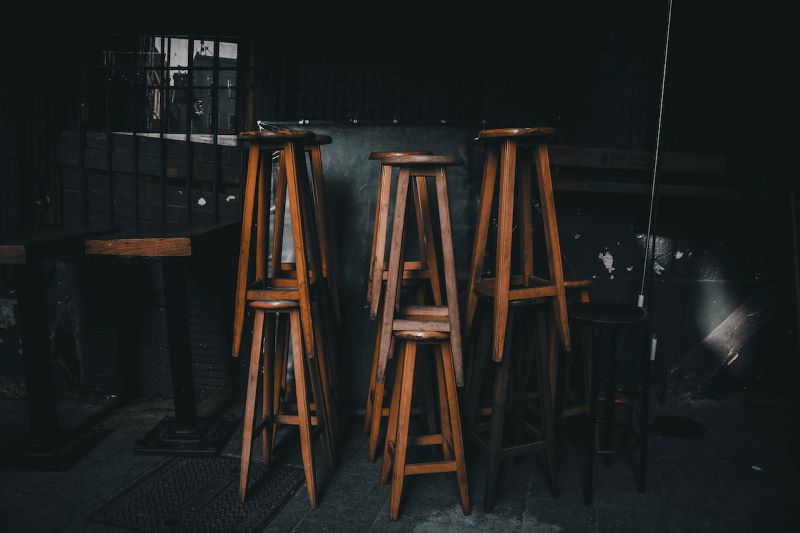Water damage can be a real downer, especially affecting your wooden furniture. Your beautiful pieces may suddenly look like they’ve been through the wringer, but not in a good way. But don’t give up just yet, because restoring water-damaged furniture is possible with the right techniques and effort.
How water damages wood furniture
Water can be a serious threat to the integrity of wood furniture. As a natural material, wood is designed to absorb water, which means it can easily swell up if exposed to too much moisture. This can lead to watermarks on the furniture’s surface, ranging from light and easy to remove to dark and deeply embedded.
Moreover, water damage can also lead to mold growth on wood furniture. Mold thrives in damp environments, making wood furniture an ideal breeding ground for mold when exposed to excess moisture. Mold growth on wood furniture can be dangerous as it can spread quickly and cause health problems for those who are exposed to it. In these cases, it’s a good idea to contact a Utah mold clean-up company.
How to salvage water-damaged furniture pieces
There are a few different techniques to restore furniture that has been hit by water damage:
Dry the swollen pieces.
Drying swollen wood furniture is a common solution to fix water damage, but it is important to do it correctly. It’s best to avoid using artificial means such as a hairdryer or blower and instead let the furniture dry naturally. Direct sunlight is a good option, but the drying process should not be too fast, as the wood may break or warp. Therefore, it is important to exercise patience and give the furniture enough time to dry completely.
Use a belt and finishing sander.
A belt and finishing sander can be an effective solution to fix minor damage to your wooden furniture. This technique involves using sandpaper to scrub the problem areas and applying just the right amount of pressure to avoid further damage.
If the furniture is already stained, you may need to apply a new stain to the problem areas to match the existing color. Using an oil-based stain that matches the furniture’s original color is recommended, and you may need to experiment with different stains to get the exact match. Once the problem areas are fixed, apply a quality wax to give your furniture a good-as-new finish.
Fix white and black rings.
Water damage can leave unsightly white and black rings on your wooden furniture. White spots can be treated by creating a cleaning solution using baking soda and toothpaste mixed in equal amounts. Dip a damp cloth into the solution and scrub it over the spots. Once the furniture is free of white spots, polish it with a dry cloth to restore its shine.
The black spots are harder to treat because they indicate that water has penetrated deep inside the wood, allowing mold to grow. To eliminate them from the piece, you’ll need to strip the upper finish of the wood and the mold using a peroxide cleaning solution. Once done, coat the affected area with a new finish. P.S. – Remember to take precautions and wear gloves and a mask when dealing with mold, as it can be harmful to your health.
Glue loose joints.
One common problem that often arises as a result of water damage is loose furniture joints. When joints become loose, they can cause an entire piece to wobble or become unstable, making it difficult to use or even dangerous to be around.
To the issue, start by carefully removing any old glue from the joints. This can be done by sanding between the joints with rolled-up or folded 150-grit sandpaper. Once the old glue is removed, use a clean paintbrush to remove any wood dust and sanded glue.
Next, apply wood glue inside the joint and reattach the loose piece. To ensure a secure fit, hold the piece in place with clamps or braces for 12 to 16 hours. If you are dealing with intricate, delicate raised wood pieces or hard-to-glue sections, consider using epoxy wood glue for added strength and durability.
Treat the crumpled furniture veneer.
Veneer furniture is a popular type of wooden furniture that consists of thin slices of wood glued to a substrate, often made of man-made wood. However, even with its durable construction, veneer furniture is still susceptible to water damage, particularly on its surface and between its glued joints.
Fortunately, there are several ways to reinstate a water-damaged furniture veneer. One way is to soak the veneer with a moisturizer till it goes flat. After it reaches that state, use a cloth to clean it and then dry it off.
Then fill the veneer glue in a syringe and inject it slowly on the surface, pointing the needle between the coating and the furniture. As the glue accumulates on the wood, remove the syringe and place a heavy block over the area to help the veneer stick properly.
Get in touch with a Utah water damage restoration specialist.
Water damage, whether it’s from a flood or other occurrence, can cause significant harm to your wooden furniture. But there are various methods for restoring it to its former glory. Depending on the extent of the damage, you may be able to tackle the restoration process yourself using some of the techniques we’ve discussed, such as sanding and refinishing or using a wood stain.
However, if you’re dealing with severe water damage, it’s best to enlist the help of a professional restoration company. A Utah flood restoration specialist can provide the expertise and equipment necessary to fully restore your damaged furniture and protect it against future damage. Don’t hesitate to seek assistance if you need help with water damage restoration.

